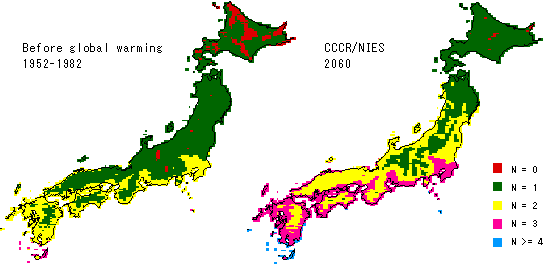Global warming may affect crop damage caused by insect pest, by
changing the degree of synchronization between pest occurrence and the susceptible
stage of crops. The epidemiological system of rice stripe virus disease (RSV disease)
transmitted by the small brown planthopper, Laodelphax striatellus (Fallen),
is greatly influenced by synchronization, because the susceptible stage for virus
infection is within several weeks after transplanting. We calculated how the area
potentially vulnerable to RSV disease will change under future global warming
by using the results of the Global Climate Model (GCM) experiments reported by
the Intergovernmental Panel on Climate Change. For simplicity, assuming that rice
seedlings are transplanted from May to June, we made a map, in which the number
of generations of the small brown planthopper on June 1 was plotted by calculating
the effective cumulative temperature. The influence of solar radiation was also
considered in this calculation. We judged that the area located near the boundary
of generations is potentially vulnerable to disease prevalence, because planthoppers
are in the adult stage there. Generation maps indicated that the Tohoku and Hokuriku
districts, which are major districts of rice production in Japan, might be potentially
vulnerable to disease infection under future global warming. (Copyright by the
Japanese Society of Applied Entomology and Zoology)

Figure 1. (Left panel) Estimated number of generations (N)
of the small brown planthoppers on June 1 under the baseline climate before global
warming (average of 1952-1982). (Right panel) Estimated number of generations
(N) of the small brown planthoppers on June 1 in the 2060s under global
warming, estimated by the GCM model, CCSR/NIES. N = 0 indicates the overwintering
generation. The area around a generation boundary is liable to be infected by
RSV disease, since adult planthoppers immigrate to paddy fields in such areas.